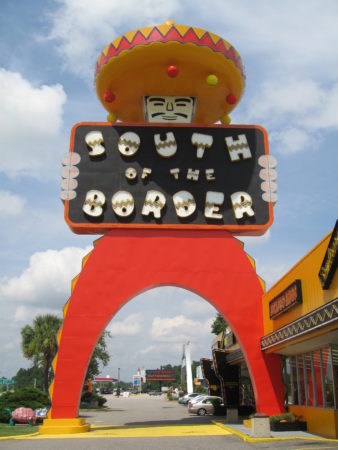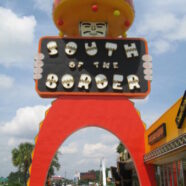For Over 60 Years, South of the Border Provides Clean, Campy Fun (Currents Magazine)

For nearly 70 years, South of the Border in Hamer has been a welcome pit stop or overnight host for weary drivers traveling up and down the I-95 corridor. But before the roadside landscape from Virginia to Georgia was brimming with miles of colorful, humorous ‘come hither’ billboards, there was Alan Schafer.
His roots run deep. Back in the late 1860’s, Alan’s German-American grandfather, Abraham, came to Little Rock, SC, and was one of the first Jews to settle in the area. Soon thereafter, in 1870, Abraham purchased a general store from his employer, Tom Dillon, and founded The Schafer Company.
In 1888, son Sam Schafer was born, eventually growing up to assume the role of general manager of the dry goods portion of The Schafer Company, while father Abraham continued to oversee the grocery and hardware divisions. Alan first entered the scene in 1914, and ultimately graduated from Dillon High School in 1930. That same year, he left for Columbia and attended the University of South Carolina, where he was pursuing a major in journalism.
However, in 1933, shortly before Alan’s senior year, his father, Sam, implored him to return home, as Abraham’s health was failing. The eldest Shafer passed away that fall, just as an unlikely new business opportunity surfaced. Realizing the potential in the repeal of Prohibition, Sam took a trip to Baltimore and returned with a truckload of beer. It didn’t take long before they discovered that the same people who had struggled to pay their grocery bill were somehow able to purchase the bottles of ale.
THE EARLY DAYS
Soon thereafter, father Sam and son Alan formed the Schafer Distributing Company. Alan passed away in 1945, but Alan continued to grow the business, eventually expanding it to include warehouses in North Carolina. In 1948, North Carolina passed a ‘local option’ law, which allowed for county-based legislation regarding the sale of alcohol. Robeson County, across the border from Dillon, was the first to vote it into effect, suddenly becoming a dry county. Recognizing the favorable circumstances, Alan purchased three acres of land on U.S. 301 and built an 18’ x 36’ cinderblock building on the site. Legend has it the building materials for the structure were addressed to the “Schafer Project South of the North Carolina Border,” a name that inspired Alan to dub his new enterprise “South of the Border Beer Depot.” Soon, he was legally selling up to two cases of beer per person, intended for transport across the state line.
At its inception, the beer depot had a six-stool bar area. To appease North Carolina lawmakers and the Robeson County sheriff, the space was soon expanded into a grill selling hot dogs and hamburgers. The name was also changed to South of the Border Drive-In. These modifications resulted in an unexpected boon, as it turns out the small eatery was the only place along that portion of U.S. 301 where a traveler could get a bite to eat without venturing off the highway. It did so well that, despite continued success in the beer distribution business, the restaurant’s sales were soon outpacing everything else.
Over the next two years, a small motel and gas station were added, and by the mid-1950s, the establishment’s name was abbreviated to South of the Border. Soon thereafter, the campy Mexican theme emerged, along with the trinkets and memorabilia still sold today. “My grandfather went down to Mexico to source all that at first,” recounts Ryan Schafer, Alan’s grandson and the current owner of S.O.B. “Two of the guys he met on a trip down there wanted to come back to the United States, so he helped them immigrate and gave them jobs as bellboys in the motel.”
As the Mexican employees settled into their new lives and posts at the burgeoning South Carolina enterprise, visitors began to refer to them both as ‘Pedro,’ thus sealing the deal on what has now become an occasional source of discomfort, dispute and misunderstanding in online reviews and publications. While there are some who find Pedro and the kitschy Mexican-themed products and trinkets insensitive or even racist, Ryan reports it’s rarely an issue with visitors.
“Most people enjoy the Pedro theme, and understand it’s good-natured,” Ryan notes. “Every now and then we get somebody that complains, but, honestly, they’re never Mexican or even Hispanic.” As for the Mexican men that originally inspired the trope? “They still live around here,” says Ryan. “They’ve got to be in their 70’s — or older — by now, but they come by, and we see them from time to time.”
EXPANDING THE BUSINESS
In 1956, Eisenhower announced the inception of the National System of Interstate and Defense Highways, a plan to construct a national road grid. A new highway, spanning from Miami to the Houlton–Woodstock Border Crossing in Maine, was planned. When Alan Schafer learned it would enter South Carolina near the junction of U.S. 301 and U.S. 501 and within the range of his current ventures, he began buying up land in the area. This shrewd act of foresight ultimately resulted in today’s South of the Border tourist complex.
While the enterprises and entertainment found at S.O.B. have shifted over the decades, these days, the 300-acre roadside attraction offers 100 full hook-up RV sites, plus a 300-room motor inn boasting both indoor and outdoor pools. There are also two gas stations, as well as six restaurants, including the dinner-only Peddler Steak House and the hat-shaped Sombrero Restaurant, which matches customer’s donations to the Shriner’s Children’s Hospital and commemorates them on the wall.
Along with a 200-foot tall sombrero-topped observation tower (whose neon glow can be seen lighting the night sky for miles in every direction), South of the Border features a convention and banquet center that can accommodate up to 700 guests. You may wonder who’s booking these facilities. “People get married here all the time,” shares Ryan, “probably around 20 couples every year, maybe more. Sometimes it’s because they came here when they were kids, and up until the 80s, it was a lot easier to get married here in South Carolina because we didn’t require a blood test. We’ve got two people on staff that can legally perform the marriage. We can do it with a day or so of notice.”
Even if tying the knot isn’t in your plans, there are still opportunities for selfies galore. Along with a cast of giant, whimsical, Instagram-worthy statues (including a bright red, 100-foot long Dachsund/weiner dog), available for purchase is pretty much every form of souvenir known to man, ever. Always wished for a picture of yourself in a heavily embellished sombrero or ten? This is the place.
For the young and young at heart/lower back, Pedroland is an amusement park featuring a Ferris wheel, bumper cars and a simulator ride, among others. There’s also an arcade, located in the base of the sombrero observation tower, as well as two, 18-hole championship miniature golf courses, the professional Master’s of which is held every October in North Myrtle Beach.
Fort Pedro’s Fireworks Shop is why Ryan reports that July is South of the Border’s busiest time, “We sell a lot of fireworks. Even though they’re legal in a lot of places now, they’re still very popular. We also sell a lot of sombreros and a lot of key chains,” he continues. ““And lately we’ve gotten into Mexican pottery, such as Talavera animals from the Puebla area.”
Indeed, along with the self-proclaimed “largest stock of fireworks on the East Coast,” the souvenir shops are chockablock with S.O.B. memorabilia and a rather extraordinary assortment of Mexican items. But it’s not all shot glasses and sombreros. There are also intentionally campy and off-color gifts, like plastic poop, a roll with packaging emblazoned with “Generic Toilet Paper for Cheap Bastards” or adult gag gifts like the, ahem, ‘Peter meter.’
As for the hops-flavored alcoholic beverage that started it all? “We still sell beer,” confirms Ryan. “Our selection is fairly extensive, but it’s not a huge part of the business anymore. North Carolina is no longer dry, and they can even buy it there on Sundays.”
RECENT DEVELOPMENTS
Alas, change is inevitable, although not necessarily a bad thing. In 2012, Ryan, an avid motocross fan, opened the cleverly-named SOBMX. It features four competition-caliber Supercross, Arenacross and motocross tracks, two of which are open to all levels of skill, and two that are limited to professionals. Speaking of whom, there is also a professional SOBMX motocross racing team, as well as a kid-filled amateur team made up of both male and female racers. And for those who might be interested in taking up the sport, there’s also a structured training program with three dedicated professionals at the helm.
But despite all that, Ryan reports that his current favorite attraction is one that doesn’t get as much love from visitors. “The Reptile Lagoon gets overlooked because it’s further from the road,” he states. “It’s our newest attraction, and as far as the doctor whose animals are displayed there and I know, it’s the largest reptile zoo in the U.S. We’ve got alligators, frogs and turtles, along with hundreds of snakes. We also have several species of crocodiles, along with a huge snake that’s something like 21 or 22-feet long.”
There’s also a giant tortoise from Aldabra, Africa in the Indian Ocean, plus the New Guinean Fly River or pig-nose turtle, a rare freshwater turtle that has true flippers like the ocean-going varieties. While a percentage of every admission fee is donated to the Crocodile Conservation charity, the Reptile Lagoon isn’t a non-profit affair. As visitors exit, they pass through the gift shop, filled (perhaps not surprisingly) with a plethora of reptile-themed souvenirs.
As for the future of this long-standing, family-run business, Ryan notes, “I’ve got a son, but he’s only 12 and hasn’t shown much interest in running South of the Border yet.” While that’s understandable, no doubt the throngs of hungry, curious travelers who visit the nostalgic pit stop every year are hoping that the young Schafer eventually changes his mind and one day dons the symbolic sombrero.






